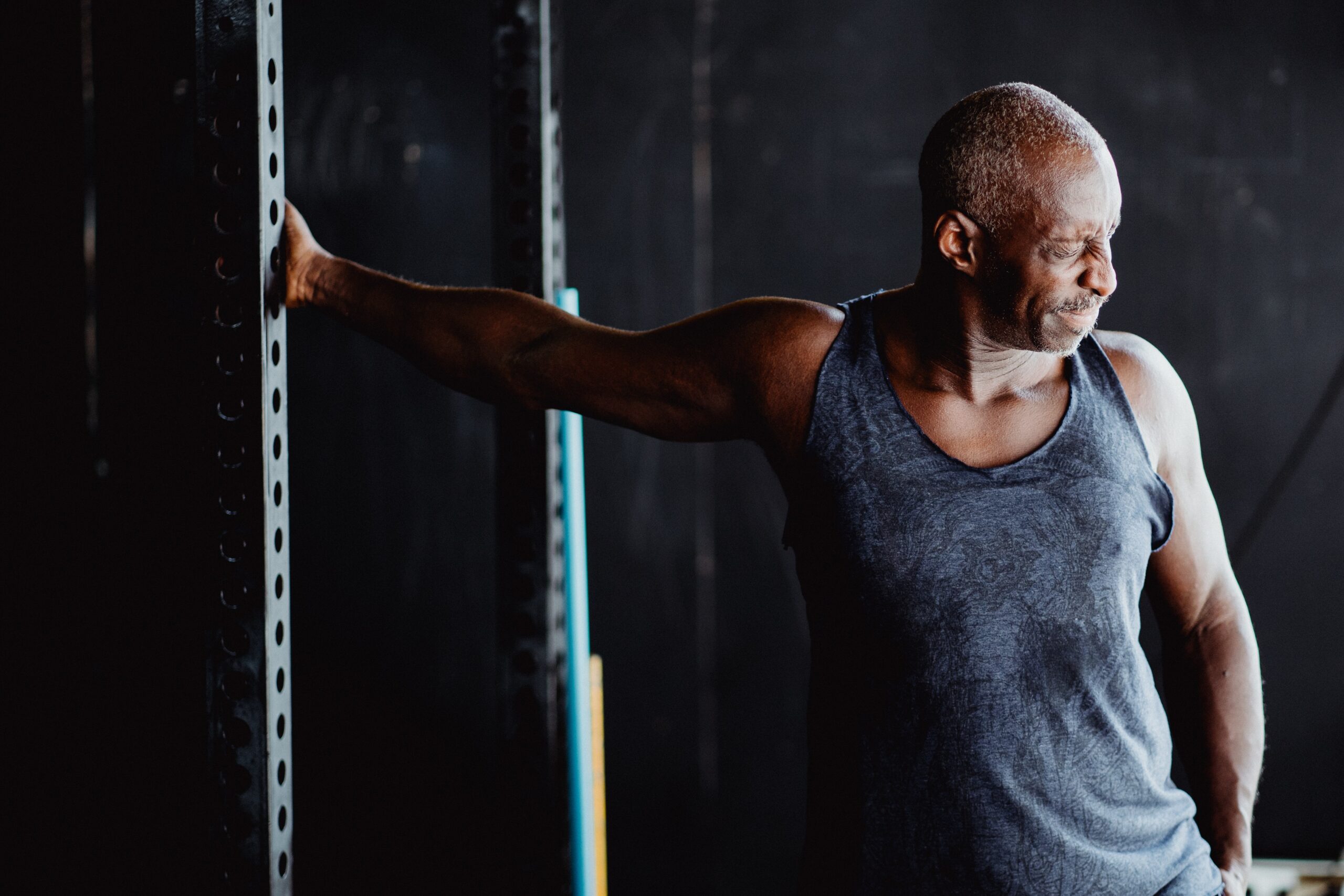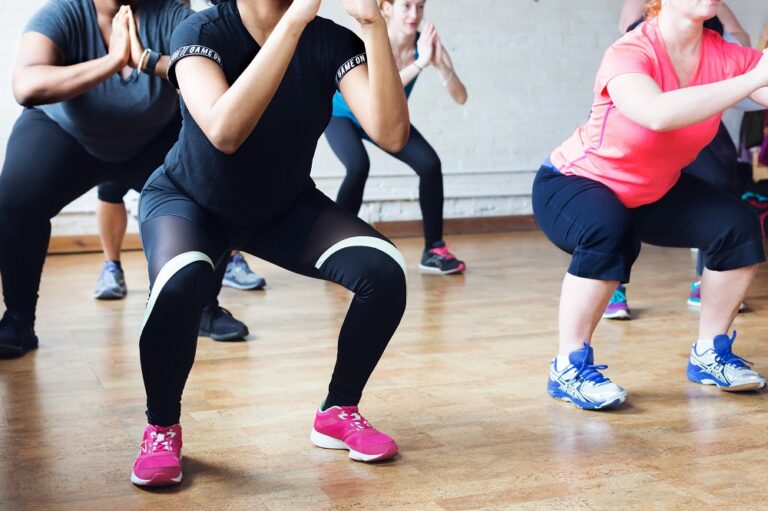Rotator Cuff Tears: The Basics
A rotator cuff tear is a common injury among adults that results in shoulder pain, limited shoulder mobility, and sometimes weakness.
It is estimated that approximately 180,000 Canadian adults develop symptoms of a rotator cuff tear.
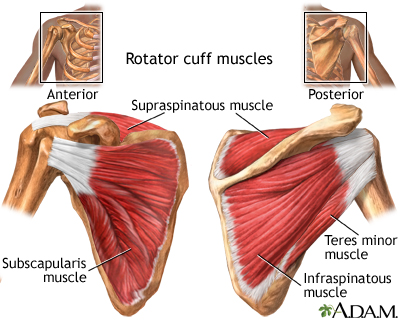
The rotator cuff is a group of muscles and tendons that work together to stabilize the shoulder joint.
These muscles and tendons keep the head of your upper-arm bone (humerus) in the shoulder socket, and help you raise and rotate your arm.
The rotator cuff is made up of four muscles; each with its own tendon that attaches to the upper arm bone and each with its own important function:
- Supraspinatus – keeps your upper arm stable and allows you to raise your arm
- Infraspinatus and Teres minor – work together, allowing you to rotate and extend your arm and shoulder
- Subscapularis –allows you to rotate your arm, hold it out straight, as well as lower it
Types of rotator cuff tears
A rotator cuff tear can happen due to ‘wear and tear’ with older age (40+ years old), or with repetitive overhead arm motion (i.e. painting, pitching, tennis, etc.). They can also happen due to trauma caused by a fall, sudden force to the joint, or from a shoulder dislocation.
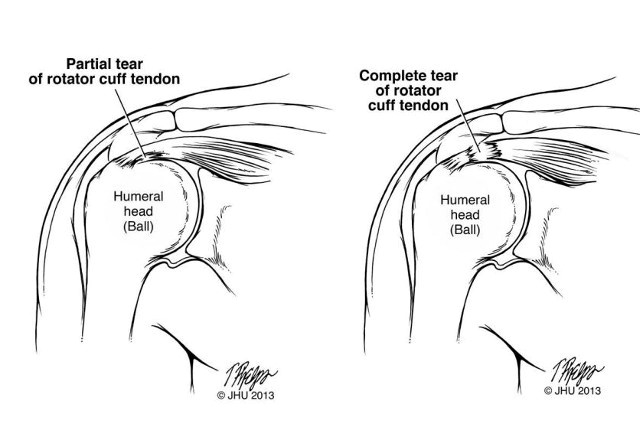
There are two main types of tears:
- Partial thickness tear – where the tendon is not completely detached from the bone. These tears occur only partially through the thickness of the tendon.
- Full thickness tears – where the tendon is separated/torn away from the upper arm bone (humerus).
The supraspinatus is the most injured tendon.
— Learn more about shoulder instability and its consequences —
Symptoms of a rotator cuff tear
Some people may have no symptoms of a tear (asymptomatic).
However, common symptoms include:
- an aching or sharp pain down the front or side of the shoulder that is aggravated by overhead activities
- discomfort reaching behind or across the body
- pain at night that is worse when lying on the affected shoulder
- weakness when rotating the arm
- a crackling (crepitus) sensation when moving the arm and shoulder in certain positions
Diagnosis of a rotator cuff tear
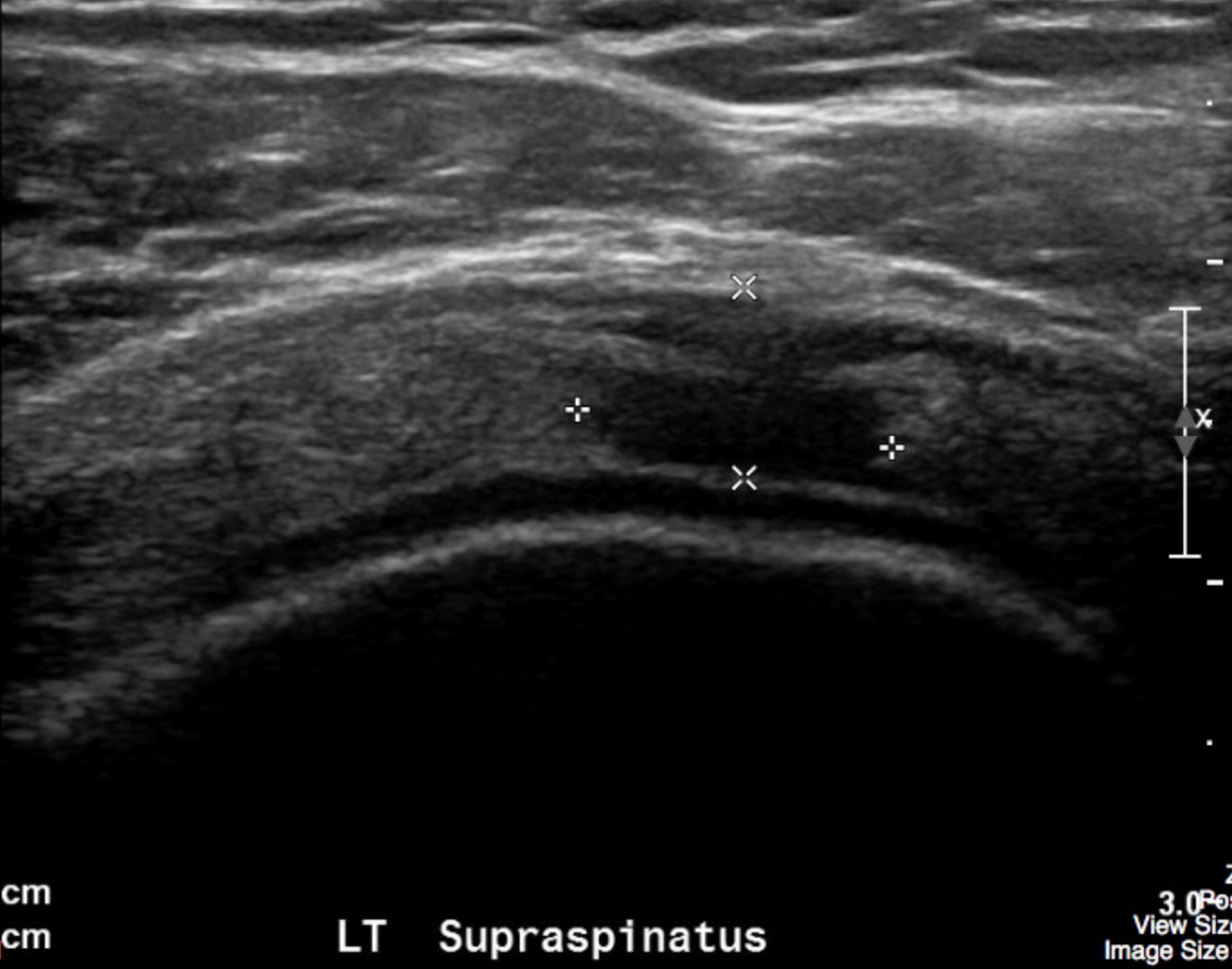
Your doctor will ask you detailed questions about your symptoms, medical history, and perform a physical examination. They will look at your shoulders and surrounding muscles, feel for deformities, and use a combination of special tests to assess how well your arm and shoulder move, as well as the strength of the muscles around your shoulder and in your arm.
The doctor may order an x-ray to rule out other causes for your symptoms such as osteoarthritis.
However, ultrasound or MRI is used to visualize rotator cuff tears and estimate tear severity.
Treatment & management of a rotator cuff tear
Treatment for rotator cuff tears can involve bother non-surgical (conservative) and surgical treatment, with the goal of decreasing pain, improving mobility of your arm and shoulder, and strengthening the muscles for optimal shoulder function.
The choice of treatment depends on the severity of the tear, the patient’s age, and overall health.
Non-surgical treatment
Non-surgical treatment and management are recommended when patients have partial tears or minimal pain.

This may include rest, ice, medication for pain relief, activity modification, and a well-designed physical rehabilitation program. Rest will help the injury to heal and prevent further damage. Medications like acetaminophen and ibuprofen can be used for pain relief and/or inflammation. In some cases, cortisone or a hyaluronic acid injection may be recommended. Physical therapy can help improve mobility, strength, and flexibility in the shoulder.
Most people experience improvements in function and pain with non-surgical treatment.
Surgical treatment
Surgical treatment of rotator cuff tears is generally recommended for patients with more severe tears or where conservative management hasn’t helped.
Most rotator cuff surgeries can occur arthroscopically using small incisions in the shoulder and a tiny camera. An open technique involving a larger incision can also be used.
After surgery, patients will need to wear a sling to immobilize the shoulder to help with healing and prevent re-injury. They will also need to undergo rehabilitation and physical therapy to regain strength and mobility in the shoulder. This process can take several months, and patients need to avoid certain activities during this recovery period to prevent re-injury.
Some tears aren’t repairable due to the severity of the damage or if the shoulder has become arthritic. These tears may require other types of surgery, such as a shoulder replacement, tendon transfer, or removal (debridement) of scar tissue.
Prevention of rotator cuff tears
Prevention is key when it comes to rotator cuff tears.
Maintaining good posture, using proper lifting technique, and avoiding repetitive overhead motions can help prevent this injury to the rotator cuff. Strengthening and stretching exercises that focus on the rotator cuff can also help prevent injuries.
With proper treatment and prevention, patients can expect to regain function of their shoulder and return to normal activities.
— Exercises you can do to prevent rotator cuff tears —
Expert Contributor

Jessica Chow, University of Alberta, MD Program, Class of 2023
References
American Academy of Orthopedic Surgeons (AAOS). Management of Rotator Cuff Injuries Clinical Practice Guideline. AAOS 2019 Mar 11. https://www.aaos.org/quality/quality-programs/upper-extremity-programs/rotator-cuff-injuries/
Bishay V, Gallo RA. The evaluation and treatment of rotator cuff pathology. Prim Care. 2013 Dec;40(4):889-910, viii
Boytim, V.B., Tyler Jr., C.V. History and Physical Examination for Identifying Rotator Cuff Tears. Am Fam Physician. 2017; 96 (9): https://www.aafp.org/pubs/afp/issues/2017/1101/od2.html
Burbank KM, Stevenson JH, Czarnecki GR, Dorfman J. Chronic shoulder pain: part I. Evaluation and diagnosis. Am Fam Physician. 2008 Feb 15;77(4):453-60
Diehr S, Ison D, Jamieson B, Oh R. Clinical inquiries. What is the best way to diagnose a suspected rotator cuff tear? J Fam Pract. 2006 Jul;55(7):621-4. PMID: 16822450.
Hanchard NC, Lenza M, Handoll HH, Takwoingi Y. Physical tests for shoulder impingements and local lesions of bursa, tendon or labrum that may accompany impingement. Cochrane Database Syst Rev. 2013 Apr 30;2013(4):CD007427. doi: 10.1002/14651858.CD007427.pub2. PMID: 23633343; PMCID: PMC6464770.
Hermans J, Luime JJ, Meuffels DE, Reijman M, Simel DL, Bierma-Zeinstra SM. Does this patient with shoulder pain have rotator cuff disease?: The Rational Clinical Examination systematic review. JAMA. 2013 Aug 28;310(8):837-47. doi: 10.1001/jama.2013.276187. PMID: 23982370.
Lansdown DA, Feeley BT. Evaluation and treatment of rotator cuff tears. Phys Sportsmed. 2012 May;40(2):73-86
Jha P, Knipe H, Weerakkody Y, et al. Rotator cuff tear. Reference article, Radiopaedia.org (Accessed on 14 Dec 2022) https://doi.org/10.53347/rID-16247
Murrell GA, Walton JR. Diagnosis of rotator cuff tears. Lancet. 2001 Mar 10;357(9258):769-70. doi: 10.1016/S0140-6736(00)04161-1. Erratum in: Lancet 2001 May 5;357(9266):1452. PMID: 11253973.
Okoroha KR, Fidai MS, Tramer JS, Davis KD, Kolowich PA. Diagnostic accuracy of ultrasound for rotator cuff tears. Ultrasonography. 2019 Jul;38(3):215-220. doi: 10.14366/usg.18058. Epub 2018 Nov 17. PMID: 30744304; PMCID: PMC6595130.
Oh LS, Wolf BR, Hall MP, et al. Indications for rotator cuff repair: a systematic review. Clin Orthop Relat Res 2007; 455:52.
Tashjian RZ. Epidemiology, natural history, and indications for treatment of rotator cuff tears. Clin Sports Med. 2012 Oct;31(4):589-604

